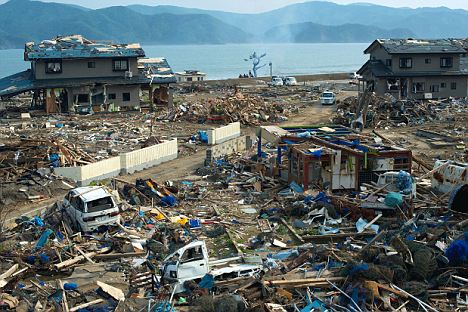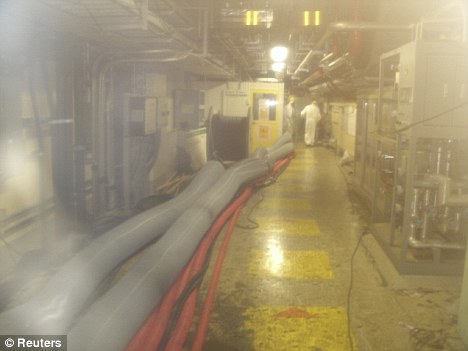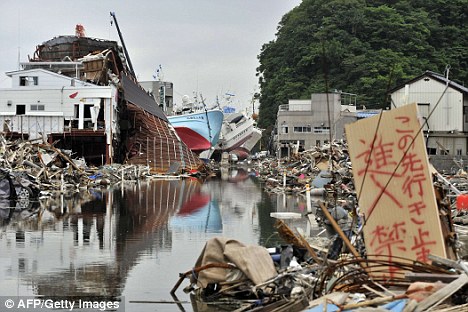
Toxic truth about Japan's 'miracle': Post-tsunami harmony is a myth and the reality is startlingly different
Richard Jones
It is almost impossible to imagine the colossal earthquake that unleashed first a tsunami and then a nuclear nightmare just 100 days ago.
The north-eastern seaboard was devastated. Some 28,000 people are dead or missing. Sixteen towns, 95,000 buildings and 23 railway stations have been destroyed. The town of Minamisanriku has simply vanished.

No change: The wrecked port of Onagawa looks as bad today as it did in the days after the tsunami and earthquake
No wonder the recovery, so meticulously documented in the media, has been described as a modern miracle. Today, the ships that balanced on tower blocks have gone. The debris has vanished from whole villages and towns.
It is further proof, we are reminded, that Japan is a society of immeasurable strength. And for this it can thank 'wa', or harmony. This is a collective feeling close to a sense of perfection. It ensures everyone knows their place and acts accordingly. Or so the Japanese like to tell themselves – and the outside world.
Yet post-tsunami Japan is far from harmonious. The bullet trains may be running, but in the fishing villages and tiny ports that litter the jagged coastline north of Sendai, thousands are surviving on aid handouts. The emergency cash promised by the government is yet to arrive.
Take Minamisanriku, the town whose devastating fate was pictured on the front page of The Mail on Sunday. There has been no miracle here. Today, it remains a nightmare of twisted metal and fragments of First World comfort. The raging 98ft wave caused annihilation. Harmony has long disappeared from Ishinomaki, too. The port town, 30 miles from Sendai, took the full force of the tsunami. It is a ghost town shrouded in the stench of rotting fish.
There is no doubt that 'wa' helped Japan to deal with its monumental problems; but it also means that victims suffer in silence. In the immediate aftermath of the tsunami, orderly queues snaked for miles for food, water and fuel. There was no looting and raping, which often accompanies natural disasters elsewhere.
Now, though, victims break down when I meet them. Mother-of-two Mrs Hiroake has lived with her family on two mats in an evacuation shelter in Ishinomaki since the tsunami hit.

Trauma: Mrs Hiroake has lived with her family on two mats in an Ishinomaki evacuation centre since the disaster
'We are living in a limbo with no privacy,' she says. 'Our lives stopped. People here are suffering mentally.'
The 254 billion yen (£1.94 billion) raised by the Japanese Red Cross for tsunami victims (including £10.5 million donated from Britain) is taking an astonishingly long time to reach the people who need it most. Just 37 billion yen has been distributed so far.
Pensions and welfare payments, too, have dried up. Mr Konno, a diabetic, can't understand why his monthly benefits of 15,000 yen (£114) stopped the moment he moved to a shelter.
Another victim, a 78-year-old widow, Mrs Utako Saito, sleeps in a tent she has pitched in her wrecked wooden cottage. She has not received her pension for three months.
With unemployment running at 90 per cent, the needy are starting to revolt. One third of families are refusing to move to temporary housing, opting to remain in shelters to hang on to their precious food benefits. Sixty per cent of the 28,000 temporary homes remain unoccupied. A staggering 90,000 people remain in shelters.
'The government don't want people to get too comfortable here, so they don't allow evacuees electricity inside the shelter,' says a volunteer from the Catholic charity Caritas.
However, the worst affected may prove to be those who lost nothing in the way of homes or relatives. They may have no running water, no money, no employment. But when compensation is finally awarded, they will be entitled to nothing.
The large hill-top home of Chieko Miura, 62, just north of Minamisanriku, became a shelter for 30 locals.
'Eventually we managed to get rice balls from the government, but there was nothing for my family because we were not “victims”,' Mrs Miura, who still looks after 12 evacuees, recalls.
'This government can be very cold-hearted. Do they want us to abandon the people we are helping?'
Tears are streaming down her face as she says this, and she apologises. Survivors have been eating little more than biscuits and dried food.
'Should we take the home with no food or stay in the shelter and eat?' says Mrs Miaki, 46, a sea-urchin fisherman, at Yariki Bay, north of Sendai.

Uncomfortable: Tatekoshi Elementary School in Natori, Sendai, Japan - one of hundreds of shelters where people who lost homes in the tsunami are living
According to Kei Watabe, who distributes food, people are not starving, 'but they are not getting enough food from the government. Japan is not the Third World. This is not Africa. The Japanese government are the first to send aid overseas, but when it comes to their own people they are blind.'
If these tsunami victims have been deprived of food, the rest of Japan has been starved of information. The Japanese are now struggling to comprehend how their government could mislead them about the nuclear meltdown that followed the tsunami.
When the Fukushima nuclear plant exploded on March 12, and again two days later, Tokyo Electric Power Company (TEPCO), the plant's operator, the government and the media, reassured the nation, and the world, that everything was under control.
It was not until May 12 that officials conceded that there had been a meltdown at not one, but three reactors. Even the timing of the announcement was cynical. It happened as inspectors from the International Atomic Energy Agency (IAEA) were about to arrive.

Nuclear disaster: Workers walking inside Fukushima Daiichi nuclear power plant Unit 2 reactor turbine building in Fukushima, northern Japan
TEPCO was able to control information through the age-old system of Press Clubs, where the government provides information to selected media.
But The Mail on Sunday spoke to sources inside the Japanese nuclear industry who knew that radiation readings spiked 155 miles south of Fukushima, immediately after the first explosion. They were told by officials to keep the findings quiet.
A survey by Fuji Television Network last month found that 81 per cent of the public no longer trusts any government information about radiation.

Still in ruins: The disaster zone in Kesennuma, Miyagi prefecture, on June 18, 2011, 100 days after the earthquake and tsunami
Food shopping has also become a problem. Shops have started mixing vegetables from different prefectures as customers are now selecting food based on where it is grown.
In an attempt to reassure the nation, the Japanese Prime Minister, Naoto Kan, visted Fukushima last month where he cheerfully ate locally grown cherries and tomatoes in front of the news cameras. As he spoke, bulldozers were removing the top soil from Fukushima school playgrounds due to high radiation levels.
Michael Penn, president of the Shingetsu News Agency, says: 'The media and the government share a cultural inclination to keep the people calm. But this time the government have badly misunderstood the public's needs.'
It is not the first time that the government and bureaucrats have neglected public safety. In the early Nineties around 1,800 people developed AIDS after being infected with untreated blood products. Most victims were dead before the Ministry of Health admitted negligence.

Pile up: Boats are still stacked against one another in Kesennuma, Miyagi prefecture, 100 days after the earthquake struck Japan
According to a well-known Japanese documentary maker, TEPCO paid for the creation of a blacklist of actors and musicians who are against the nuclear industry.
When one actor, Taro Yamamoto, joined an anti-nuclear protest, he lost his part in a popular soap opera. Yamamoto's 'crime' was to say that schoolchildren in Fukushima should not be subjected to the same annual radiation dose (20 microsieverts per year) as nuclear power workers in Europe.
One hundred days after the biggest earthquake in Japanese history, life is certainly not back to normal. One refugee told me: 'My biggest worry is that the people here will be forgotten as the media focus on the nuclear crisis.'
And 'wa', the harmony, is disappearing as people feel that their government has failed them.
June 18, 2011
